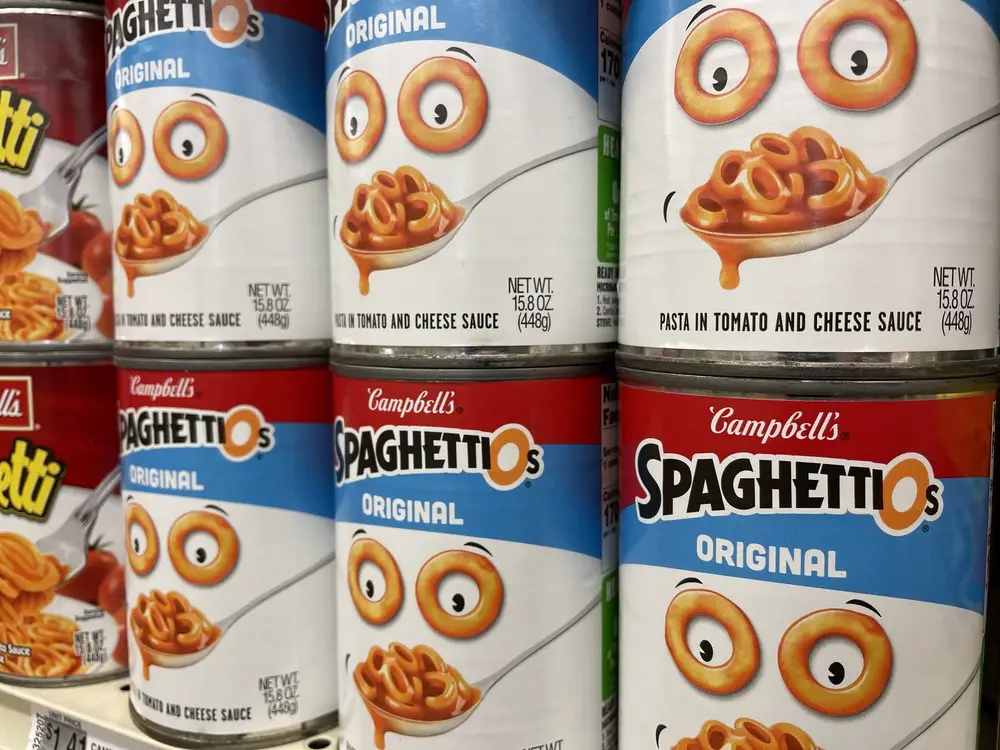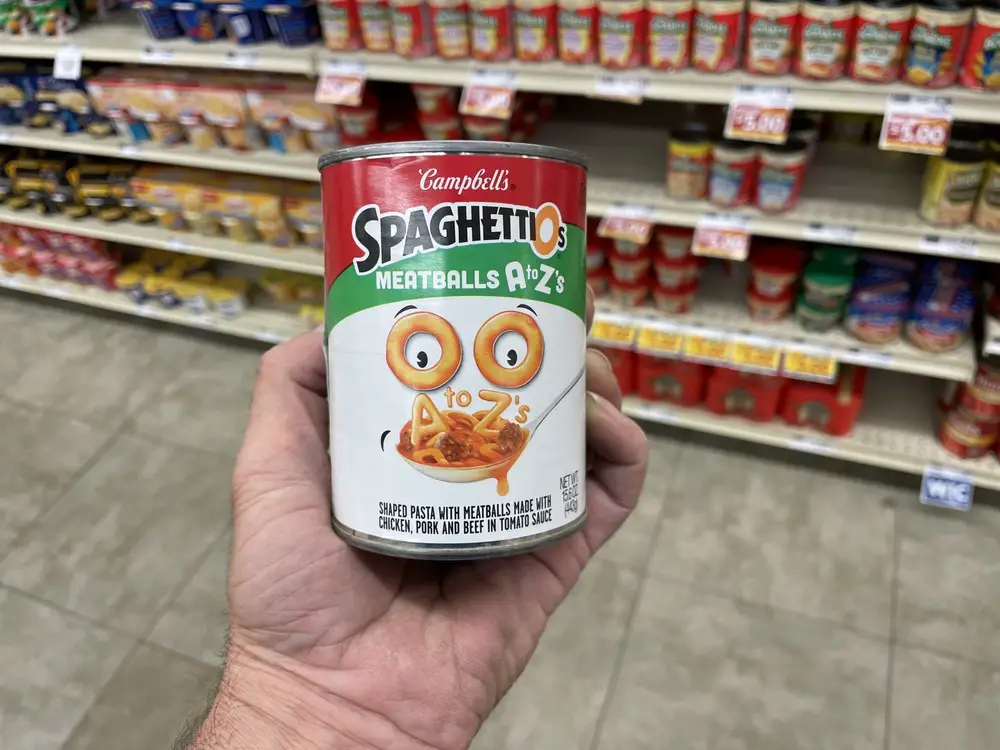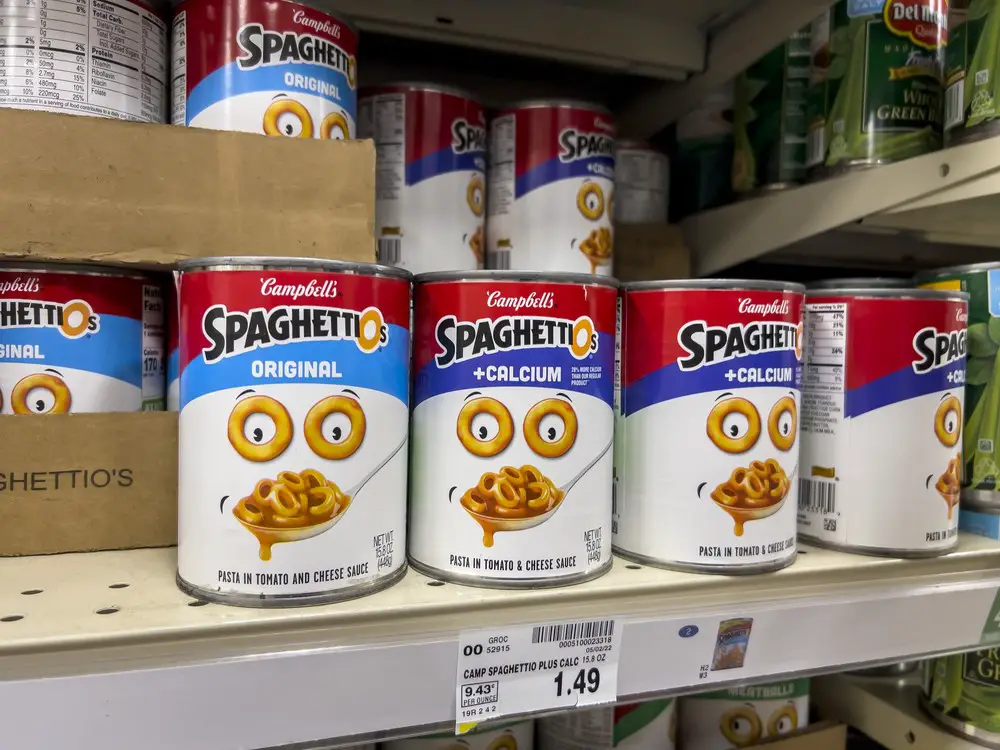Have you ever found yourself in the grocery aisle, scrutinizing the back of a SpaghettiO can with a puzzled look? If you’re living the vegetarian life, you know the drill: checking every label to see if your old favorites are still cut. SpaghettiOs, with their fun ring-shaped pasta and tangy tomato sauce, might have been a staple in your pantry once upon a time.
But now, as a vegetarian, you’re faced with the question: Can these childhood favorites fit into your new lifestyle? It’s not just about the pasta and sauce anymore. The devil’s in the details – what kind of sauce is it, and what about those extra flavorings? These things decide whether SpaghettiOs get the green light or stay on the store shelf.
Key Takeaways:
- The vegetarian-friendliness of SpaghettiOs depends on their ingredients.
- Watch out: not all SpaghettiO varieties are vegetarian, thanks to certain additives.
- Good news: vegetarian alternatives and DIY recipes for similar quick-fix meals are available.
What Are Spaghettios?
Spaghettios are a canned pasta product that intertwines pasta with tomato sauce to offer a convenient meal or snack. They’re a childhood favorite known for their O-shaped pasta, or anelli, and are considered a nostalgia-inducing pantry staple by many.
History and Popularity
Spaghettios were introduced by the Campbell Soup Company in 1965, swinging into the American culinary scene as a quick and easy meal option. They’ve become ingrained in American culture, especially as a lunchtime preference for children. The ring-shaped pasta baptized Spaghettios due to its resemblance to small spaghetti rings and was designed to be both fun to eat and mess-free. Over time, this creation has become a symbol of childhood for many and continues to cling to its popularity status across generations.
- Year of Introduction: 1965
- Original Concept: Mess-free pasta for kids
- Cult Status: Childhood favorite
Spaghettios Varieties
Over the years, Spaghettios has expanded beyond the original recipe. You’ll find various flavors and mix-ins catering to diverse preferences and dietary restrictions. Though the classic Spaghettios in tomato sauce remains a strong leader in the lineup, the roster includes options with added ingredients like meatballs, sliced franks, or cheese.
- Classic Version: Tomato sauce
- With Add-Ins: Meatballs, sliced franks, cheese
- Other Variations: Different shapes and flavors
Key Takeaway: Spaghettios are more than just pasta in soup; they’re a cultural icon and a testament to the power of marketing a simple, fun meal loved by kids and remembered fondly by adults. Whether enjoying the timeless original or exploring one of the many varieties, Spaghettios remain a pantry essential in homes across America.
Understanding Vegetarianism
Before adopting any diet, you must understand its fundamentals and how it differs from other dietary choices. Let’s break down the essential components of vegetarianism and how it compares to veganism.
Vegetarian Diet Basics
The core of a vegetarian diet is the exclusion of meat. You’ll find several variations within vegetarianism, each defined by what they do and don’t include:
- Lacto-vegetarian: Includes dairy products but not eggs.
- Ovo-vegetarian: Includes eggs but not dairy products.
- Lacto-ovo vegetarian: Includes both dairy products and eggs.
Key takeaway: A vegetarian diet avoids meat but can include different combinations of animal products such as dairy and eggs.
Vegetarian vs Vegan
The vegetarian and vegan diets have similar foundations, but with a notable distinction:
- Vegetarian: You avoid meat but may still consume animal products like dairy or eggs, which can be vegetarian-friendly.
- Vegan: You avoid all animal products. This means no meat, dairy, eggs, or even honey. Everything is plant-based, making it vegan-friendly.
This comparison helps you understand why not all vegetarian options suit vegans. If you’re considering these diets, check labels and ingredient lists to ensure they align with your dietary preferences.
Key takeaway: Vegans follow a stricter no animal products rule, while vegetarians may consume some animal-derived items.
Ingredients in Spaghettios
When peering into the world of Spaghettios, knowing what goes into the can is essential. This section unpacks the ingredients and additives that make up this pantry staple.
Key Components
Spaghettios boast a variety of ingredients that provide its characteristic taste and texture. At the heart of the product, you’ll find:
- Pasta: Made primarily from wheat flour, which includes niacin, riboflavin, and folic acid for nutritional enrichment.
- Sauce/Flavoring: The sauce is a tomato-based concoction enriched with tomato paste and seasoned with onion powder, garlic, and a blend of spices, including paprika and pepper, for that familiar flavor.
- Cheese: While cheese might be present, it’s usually in the form of skim milk or dairy ingredients to achieve a creamy texture and taste.
- Protein: Traditional Spaghettios include meat such as chicken, but vegetarian options omit animal proteins.
- Vegetables: While not abundant, there might be traces of onion extract or onion powder for flavoring.
- Fats and Oils: Some vegetable or olive oil is used in the recipe for a smooth texture.
 Additives and Preservatives
Additives and Preservatives
To maintain freshness and enhance flavor, Spaghettios include several additives and preservatives:
- Sugars: Sugar, corn syrup, and high fructose corn syrup are used for sweetness.
- Natural Flavors: These are often included to round out the taste profile without adding specific ingredients like meat or vegetables.
- Preservatives: Ingredients like citric acid help keep the contents safe to consume for longer periods.
- Color Enhancers: Paprika extract might be added to maintain the product’s appealing color.
Key Takeaway: Spaghettios mix classic pantry ingredients like wheat flour and tomato paste with cheese elements and flavorings. To elongate shelf life and maintain taste, a range of sugars, natural flavors, and preservatives are also in the mix.
Analyzing Spaghettios’ Vegetarian Status
When scanning the shelves for a quick vegetarian snack, you might pause at a can of Spaghettios. It’s essential to check the ingredients and the manufacturing process to determine if they fit into your vegetarian lifestyle.
Presence of Animal Products
Spaghettios come in various flavors, and their vegetarian status can vary. For starters, here’s a breakdown of their classic options:
- Original: Enriched pasta with tomato sauce, typically free from direct meat products.
- Meatballs: Contains meatballs, clearly not vegetarian.
- With Frankfurters: Includes sliced hot dogs, also not vegetarian.
Additionally, Spaghettios sometimes contain cheddar cheese. It’s worth noting that some cheese is made using rennet, derived from animal sources, so if you’re a strict vegetarian, you’d want to verify the type of cheese used.
Cross-Contamination Concerns
Even if a product doesn’t contain animal products directly, cross-contamination is possible if the food is made in a facility that processes meat or other animal-derived ingredients. This is a crucial consideration for stricter vegetarians or those with allergies.
- Facility: Confirm with the manufacturer whether the same equipment is used for vegetarian and non-vegetarian products.
Key Takeaway: Always read the label and, if needed, contact the manufacturer to ensure that your Spaghettios haven’t danced with meat products during production if that’s a concern for you.
Nutritional Profile of Spaghettios
When considering Spaghettios as a meal option, it’s worth understanding what’s inside the can. Here, you’ll learn about the macronutrients they offer and the vitamins and minerals accompanying the ride.
Macronutrients
Spaghettios provide a mix of carbohydrates, protein, and fat that fuel your body. Here’s a breakdown:
- Carbohydrates: Essential for energy, Spaghettios are primarily a source of carbs.
- Protein: They contain a modest amount of protein, which is crucial for muscle repair and growth.
- Fat: There’s a small amount of fat in Spaghettios, which helps you feel full.
Key takeaway: Spaghettios are a high-carb food with some protein and a low-fat content, making them a quick energy source.
Vitamins and Minerals
Spaghettios aren’t just about taste; they also include several vitamins and minerals vital for your health:
- Sodium: Be aware that sodium levels are typically high, so it’s important to be mindful of your intake if you are watching your health.
- Vitamin D: Some varieties are fortified with Vitamin D, which is good for your bones.
- Iron: They’re enhanced with ferrous sulfate, an iron that helps combat anemia.
- Thiamine Mononitrate: This is a fancy name for vitamin B1, which is important for maintaining a healthy metabolism.
Key takeaway: While Spaghettios packs essential vitamins and minerals like vitamin D and iron, keep an eye on the sodium content to maintain a balanced diet.
Homemade Spaghettios Alternatives
Creating your vegetarian-friendly versions of Spaghettios is a fun and rewarding adventure. Not only do homemade alternatives allow for personalization, but they also ensure that your comfort food is free from animal products.
DIY Vegetarian Spaghettios
With a simple recipe, you can whip up a batch of Vegetarian Spaghettios that rivals the taste of the canned classic. For your homemade concoction, you’ll need:
- 2 cups of small pasta rings
- 3 cups of tomato puree
- 1 tablespoon of basil
- 1 teaspoon of oregano
- 1/2 teaspoon of garlic powder
- Salt and pepper to taste
Steps:
- Cook the pasta according to the package instructions until al dente, then drain.
- Combine tomato puree, basil, oregano, garlic powder, and season with salt and pepper in a saucepan.
- Simmer the mixture for about 10 minutes to let the herbs infuse their flavor.
- Add the cooked pasta to the saucepan and stir until evenly coated.
Key Takeaway: You’ve got a comforting bowl of vegetarian Spaghettios; tailor the herbs to match your flavor preference.
Vegan Spaghettios Recipe
For those embracing a plant-based diet, a vegan version of Spaghettios is just as easy to make. Gather the following:
- 2 cups of small pasta rings (ensure they’re egg-free)
- 3 cups of tomato puree
- 1 tablespoon of basil
- 1 teaspoon of oregano
- 1 tablespoon of nutritional yeast (for a cheesy flavor)
- 1 tablespoon of vegan margarine
- 1/4 cup of soy milk
- Salt and pepper to taste
Steps:
- Start by boiling the pasta until it’s perfectly al dente, then drain it.
- Heat the tomato puree with basil, oregano, and nutritional yeast in another pot, sprinkling in salt and pepper.
- Once the herbs are well-blended, stir in the vegan margarine until completely melted.
- Gradually add soy milk to achieve a silky, smooth consistency.
- Mix in the cooked pasta until each noodle is coated in the luscious sauce.
Key Takeaway: This vegan spin-off will satisfy your craving and can be modified with different plant-based milks or margarines. Experiment to find your ideal taste and texture!
You quickly turn a childhood staple into a nutritious, personalized comfort dish by crafting your version at home. Plus, you have complete control over what goes into your pot, making it a healthier alternative to store-bought canned options.
Commercial Vegetarian Alternatives
When scanning the aisles for quick and easy meals, having knowledge of commercial vegetarian alternatives can save the day. Check out the brands and products that’ll keep your pantry convenient and vegetarian-friendly.
Finding Vegetarian-Friendly Brands
Finding brands that cater to vegetarian diets can be a breeze if you know where to look. Most supermarkets label their vegetarian products clearly, but here’s a handy tip: always check the ingredients list. Eggs and dairy are generally acceptable in vegetarian diets, but some prefer avoiding them. Here is a quick checklist to help you identify vegetarian-friendly options:
- Look for certifications: Products often have a vegetarian or vegan logo.
- Read the label: Ingredients like gelatin and specific E numbers are animal-derived, so watch for those.
- Research brands: Some brands specialize in vegetarian foods. Doing a bit of online research can introduce you to new favorites.
Key takeaway: Spotting vegetarian-friendly brands is about knowing your labels and sometimes researching to find the perfect match for your pantry.
Heinz Spaghetti Hoops and Comparable Products
Heinz Spaghetti Hoops have long been a staple in many households, and you’ll be pleased to know that they offer a vegetarian-friendly version. But they’re not the only ones. There’s a whole range of comparable vegetarian products out there:
- Heinz Spaghetti Hoops: The original variety is vegetarian-friendly.
- Comparable Products: Brands like Morrisons, Tesco, and Asda offer vegetarian canned spaghetti products.
Whether you’re a long-time vegetarian or just starting to explore this lifestyle, these alternatives ensure you don’t miss out on the convenience of canned spaghetti. Remember, the original Heinz Spaghetti Hoops are suitable for vegetarians, but always double-check if you’re looking for vegan options, as recipes may change.
Key takeaway: Heinz Spaghetti Hoops are a go-to for a quick vegetarian meal, and a whole world of similar products is waiting for you to try.
 Making Spaghettios Suitable for Kids
Making Spaghettios Suitable for Kids
Providing a meal that kids love while ensuring it’s nutritious can be quite the balancing act. Let’s walk through making Spaghettios, a childhood favorite, both nutritious and fun.
Balancing Taste and Nutrition
When it comes to feeding your kids, taste and nutrition must go hand in hand. For a healthier version of Spaghettios:
- Noodles: Opt for whole grain or legume-based noodles to boost fiber and protein.
- Cheese Sauce: Prepare a homemade sauce with real cheese. Reduce fat using skimmed milk and add pureed veggies for extra nutrients.
- Spices: Sprinkle in mild spices like garlic and onion powder to enhance flavors without adding extra salt.
Key takeaway: A few intelligent swaps can make those iconic noodles a win-win for taste and health.
Fun and Healthy Twists on the Classic
Turning Spaghettios into a dish that’s entertaining and good for your little ones doesn’t have to be complicated.
- Get creative by stirring in shapes like stars or hearts made from vegetables.
- Enhance the classic cheesy flavor with a mix of cheeses, including reduced-fat ones.
- Change it up by adding healthy toppings such as diced tomatoes or shredded spinach for a pop of color and a punch of vitamins.
Key takeaway: With these playful tweaks, you’ll keep the fun alive and serve up a helping of health.
Frequently Asked Questions
When it comes to SpaghettiOs, whether you’re vegetarian or vegan, you’re likely curious about its ingredients. Let’s dive into the specifics to ensure your dietary choices are respected.
Do SpaghettiOs contain any meat or animal-based ingredients?
SpaghettiOs original variety includes animal-based ingredients like meatballs made from pork and chicken. You’ll want to opt for the meat-free versions if you’re vegetarian.
Can vegans safely consume canned SpaghettiOs?
Most canned SpaghettiOs are not vegan as they often contain dairy products in the cheese and sauce. However, the label on the can will guide you, so always check for vegan certification.
What are the non-dairy alternatives to SpaghettiOs?
Looking for a substitute without dairy? Plant-based canned pasta options mimic the taste and texture of SpaghettiOs but are made with non-dairy cheese and sauce.
How can one make a vegan version of SpaghettiOs at home?
Crafting a vegan SpaghettiO at home is quite simple:
- Grab some round pasta.
- Whip a sauce with tomato paste, water, and your preferred seasonings.
- Toss in nutritional yeast for a cheesy flavor without dairy.
Are there any vegan brands that offer a product similar to SpaghettiOs?
Yes, there are vegan brands with similar products:
- Companies like Amy’s Kitchen offer vegan canned pasta options.
- Several brands in health food stores and larger supermarkets specialize in plant-based foods.
What ingredients are used in the sauce of SpaghettiOs for those following a vegan diet?
For a vegan sauce in commercial products, you’ll find ingredients like:
- Tomato puree
- Water
- Sugar and various seasonings
Double-check for non-vegan additives like cheese or milk proteins.

